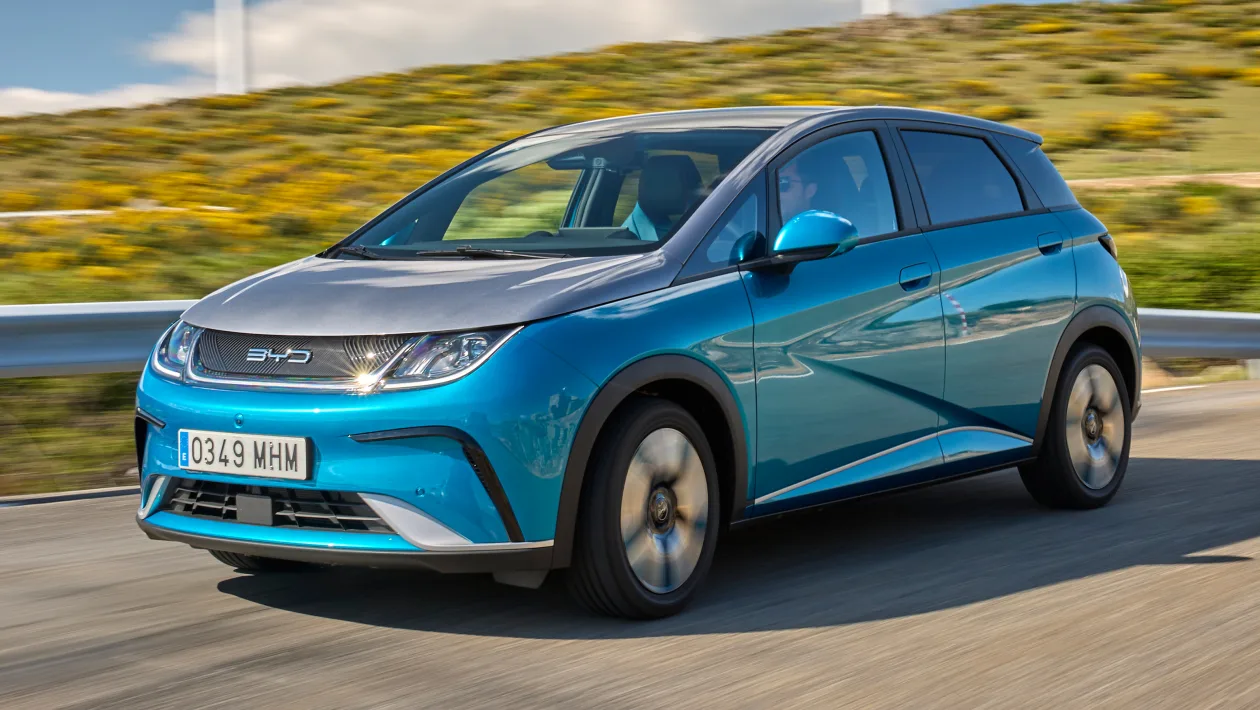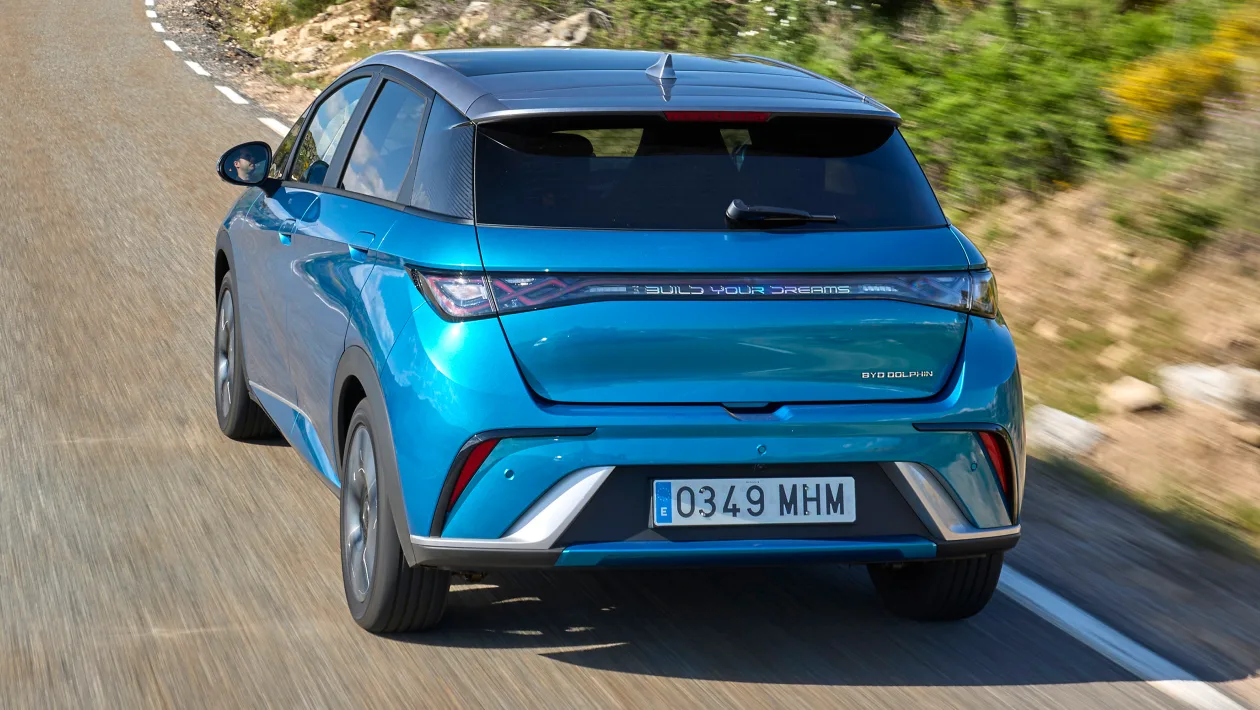The new BYD Dolphin should leave mainstream manufacturers very worried.
Cheap electric cars remain few and far between. Right now, only a handful list for less than $50,000.
The BYD Dolphin is an exception to that rule, however. While Australian pricing is yet to be confirmed, it has slipped under the equivalent of $40,000 in the UK, and locally its distributor has said it will be “Australia’s most affordable, high quality electric vehicle.”. That means it will have to be cheaper than the current cheapest offering: the MG 4 which starts from $38,990 before on-road costs are added.
On paper, it looks to be a very serious threat to established players. While local specifications are to be revealed imminently, overseas spec shows the base versions get a 45kWh battery (due Q1 2024) good for up to 340km of range – though with only 68kW, we suspect this version could feel a little lethargic out of town. Regardless, every car gets a 12.8-inch touchscreen, electrically-adjustable vegan leather seats, alloy wheels and 360-degree cameras.
Stepping up from Dolphin Active to Dolphin Boost brings a more powerful 128kW motor and a bit more kit, which in turn has a detrimental effect on range. This version, BYD says, will do just 311km on a charge.
It’s for this reason, we think the Dolphin Comfort could be the pick of the line-up. It gets the same 60kWh battery and 150kW motor as the larger BYD Atto 3 Extended range, and is good for up to 426km between top-ups. There’s slightly faster charging – more on that later – as well as heated front seats, front parking sensors and an upgraded stereo.
Sitting atop the range is the car we were driving here to sample on Spanish roads, the Dolphin Design. It features the same battery and electric motor, but brings two-tone paint, a full-length panoramic roof, rear privacy glass and wireless phone charging, as well as a tri-colour design for the 17-inch alloy wheels.
Inside, the Dolphin does just enough to disguise its bargain price. The materials are hard wearing, but subtle texture on the dashboard and doors gives the illusion of something more premium. There’s plenty of colour, and the fake-leather on the seats and steering wheel give a softness to these common touchpoints. The buttons have a more reassuring weight to them than those you’ll find in an MG 4.
And then there’s the infotainment system. Not to be distracted by its party trick – that is, its ability to rotate 90 degrees depending on your preference – the software hidden within is definitely more responsive and slick to the touch than some others. We still don’t find the BYD’s menu layouts all that intuitive, but the functionality is there should you wish to use it.
Sitting in the driver’s seat – or indeed the passenger seat, which doesn’t offer any kind of height adjustment – we were left wanting for a bit more adjustability; the lack of thigh support showed up the Dolphin’s longer-distance ergonomic flaws in particular. But otherwise we found visibility to be good and space to be generous no matter whether you were sitting in the front or the back.
The good news continues on the road. Before joining the motorway, our drive took us along a bumpy track away from the launch venue, whereby the Dolphin’s accomplished ride immediately showed itself in a positive light. All but the cheapest Active cars get multi-link rear suspension, and its ability to deal with ruts and bumps at low speeds should all but ensure its suitability for Australian buyers looking solely for a low-cost urban runaround.
Yet even on faster roads the smallest BYD retains its composure. Body control is impressive, and where those seats lack support at the base, the substantial side bolsters tie you in during faster cornering. The steering is a little light and there is very little feel, but it’s direct and grip is good.
This may be due to our particular test car’s distinct lack of straight-line punch, though. Despite being fitted with the most powerful motor – which BYD claims is capable of 0-100km/h in seven seconds flat – our tests didn’t come close to the official numbers. Our car felt sluggish off the mark and more consistent with the least powerful (68kW) motor when gaining speed, the company’s engineers ensured they’d look into the fault and provide us with a replacement car at the earliest opportunity. As it stands, the Dolphin seems some way shy of its main rivals for straight-line speed.
This aside, the Dolphin is quiet – albeit with an external sound reminiscent of an ice cream van when creeping around town. It’s not all that noticeable from inside the cabin, but certainly grabs the attention of passers-by in tight city streets. The brakes felt easy to modulate, though those who favour the efficient driving style of a one-pedal setup will be disappointed; even the stronger of the BYD’s two regenerative braking settings scrubs so little speed it’s almost not noticeable.
But we did find the Dolphin to be remarkably efficient over our near-160km test route – easily returning 6.4km/kWh during motorway stints and over a long, unforgiving section in the hills above Madrid. We reckon you’d easily see that figure hit 8km/kWh carrying out more mundane duties, while the standard-fit heat pump should help in the colder months.
Recharging the battery is possible at speeds of up to 88kW (on par with a Kia Niro EV), meaning a 30-80 per cent top-up is achievable in 29 minutes. Dolphins fitted with the smaller battery get slower 60kW charging but can still do that benchmark 80 per cent charge in roughly the same time.
Many car makers have mooted the idea of $40k EV, but BYD is putting its money where its mouth is. We’ll wait to drive a car with the necessary software upgrades on Australian roads before delivering our definitive verdict, but performance aside, the Dolphin should leave mainstream manufacturers very worried. This is an electric car that delivers on range, efficiency, space, technology and dynamics, while undercutting all of its main rivals on price. We hoped it’d be good, but we weren’t expecting such a well-rounded package.












